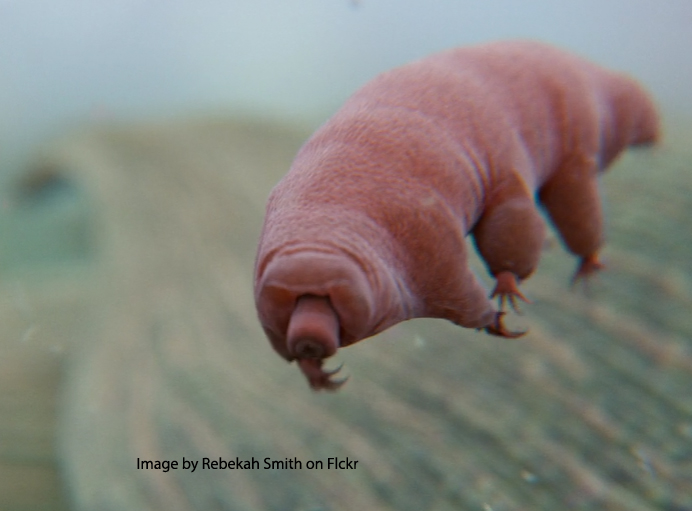This is a water bear, discovered by Johan Goeze in 1773 and renamed for its bear-like appearance and movement a tardigrade (“slow steppers”) by Lazzaro Spallanzani. They are small, short, and plump, with four pairs of legs ending in claws or suction cups; in short, they are adorable. They are also highly resilient to ionizing radiation. The reason for that resilience is the subject of a study in Current Biology.
 The LD50, the lethal dose of radiation for 50% of humans, is roughly 5 Gray – or Gy, the amount of absorbed radiation. A typical abdominal CT involves roughly .010 Gy, so you would need approximately 500 CT scans, one after another, to experience a 50% chance of receiving a lethal dose. The tardigrade, specifically Hypsibiius exemplaris, can tolerate 4,000 Gy without a sustained injury to their DNA. Other species of tardigrades produce a protein (Dsup) that binds to their DNA and its packaging by histones (nucleosomes), protecting them from the harmful effects of ionizing radiation’s production of free radicals from damaged cells. However, these genes are not preserved across all tardigrade species, so the researchers sought other explanations.
The LD50, the lethal dose of radiation for 50% of humans, is roughly 5 Gray – or Gy, the amount of absorbed radiation. A typical abdominal CT involves roughly .010 Gy, so you would need approximately 500 CT scans, one after another, to experience a 50% chance of receiving a lethal dose. The tardigrade, specifically Hypsibiius exemplaris, can tolerate 4,000 Gy without a sustained injury to their DNA. Other species of tardigrades produce a protein (Dsup) that binds to their DNA and its packaging by histones (nucleosomes), protecting them from the harmful effects of ionizing radiation’s production of free radicals from damaged cells. However, these genes are not preserved across all tardigrade species, so the researchers sought other explanations.
Through a variety of tests, they showed:
- Tardigrades exposed to both a “well-tolerated dose of 2,180 Gy and a near LD50 of 4,360 Gy experienced damage to their DNA.
- Tardigrades can sense the presence of DNA damage from ionizing radiation.
- They respond by significantly increasing the transcription of genes for proteins for DNA repair. This includes base repair, mismatch repair, and nucleotide excision genes. This response is far greater than a similar response to DNA from desiccation or other stressors.
- The increase was 32-fold compared to a 2-fold increase in some mammalian cells exposed to ionizing radiation. Many of these pathways are invoked when tardigrades are extremely dehydrated or desiccated, another condition where tardigrades are exceptionally resilient and their DNA damaged. [1]
- This reparative response is almost immediate, occurring within hours of exposure and persisting for longer intervals.
- The transfer of these reparative genes to E. coli resulted in greater survival of the bacteria due to ionizing radiation.
In short, tardigrades have evolved unique ways to address their ecologic niche, with early protection from Dsup, the damage suppressor protein, to the enhanced re-targeting of the proteins involved in DNA repair and the coordination of that response. Having only examined one of many types of tardigrades, it remains to be seen whether those living in a watery environment have the same or different repair trajectories to radiation.
These mechanisms may also be harnessed to meet our more human needs. From protecting astronauts during space travel to the more day-to-day needs of those undergoing radiation therapy, the therapeutic targets of Dsup’s protection and tardigrade’s upregulating DNA repair may find an important use.
In a world where change is the only constant, “survival of the fittest” refers to adaptability and resilience. Over the millennia, nature has tried numerous experiments; by exploring and understanding the biology of the other creatures we share the planet with, we might find more unique solutions like tardigrades for radiation.
[1] This resilience to desiccation is consistent with tardigrade’s ecologic niche, often found in moss, which can lose essentially all of its intracellular water and then return to full function after rehydration.
Source: The tardigrade Hypsibius exemplaris dramatically upregulates DNA repair pathway genes in response to ionizing radiation Current Biology DOI: 10.1016/j.cub.2024.03.019




